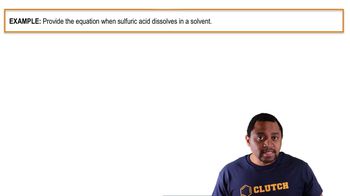The solubility product for Zn1OH22 is 3.0 * 10-16. The formation constant for the hydroxo complex, Zn1OH242 - , is 4.6 * 1017. What concentration of OH- is required to dissolve 0.015 mol of Zn1OH22 in a liter of solution?
Ch.17 - Additional Aspects of Aqueous Equilibria
Chapter 17, Problem 110a
(a) Write the net ionic equation for the reaction that occurs when a solution of hydrochloric acid (HCl) is mixed with a solution of sodium formate 1NaCHO22.
 Verified step by step guidance
Verified step by step guidance1
Identify the reactants: Hydrochloric acid (HCl) and sodium formate (NaCHO_2).
Write the balanced molecular equation: HCl(aq) + NaCHO_2(aq) \rightarrow NaCl(aq) + HCHO_2(aq).
Dissociate all strong electrolytes into their ions: H^+(aq) + Cl^-(aq) + Na^+(aq) + CHO_2^-(aq) \rightarrow Na^+(aq) + Cl^-(aq) + HCHO_2(aq).
Identify the spectator ions: Na^+(aq) and Cl^-(aq) are present on both sides of the equation.
Write the net ionic equation by removing the spectator ions: H^+(aq) + CHO_2^-(aq) \rightarrow HCHO_2(aq).

Verified video answer for a similar problem:
This video solution was recommended by our tutors as helpful for the problem above.
Video duration:
4mWas this helpful?
Key Concepts
Here are the essential concepts you must grasp in order to answer the question correctly.
Net Ionic Equations
A net ionic equation represents the chemical species that are involved in a reaction, excluding spectator ions that do not participate in the reaction. It focuses on the actual chemical change occurring, providing a clearer picture of the reaction's essence. To write a net ionic equation, one must first write the balanced molecular equation, then dissociate the soluble strong electrolytes into their ions, and finally eliminate the spectator ions.
Recommended video:
Guided course

Net Ionic Equations
Acid-Base Reactions
Acid-base reactions involve the transfer of protons (H+) between reactants. In this context, hydrochloric acid (HCl) acts as a strong acid, fully dissociating in solution to release H+ ions. Sodium formate (NaCHO2) can act as a weak base, accepting protons. Understanding the behavior of acids and bases is crucial for predicting the products of their reactions.
Recommended video:
Guided course

Acid-Base Reaction
Dissociation of Electrolytes
Dissociation refers to the process by which an ionic compound separates into its constituent ions when dissolved in water. Strong electrolytes, like HCl and NaCHO2, dissociate completely in solution, while weak electrolytes do not. Recognizing which compounds dissociate and how they behave in solution is essential for writing accurate chemical equations and understanding the resulting ionic interactions.
Recommended video:
Guided course

Strong Acid Dissociation Example
Related Practice
Textbook Question
Textbook Question
The value of Ksp for Cd(OH)2 is 2.5 × 10-14. (a) What is the molar solubility of Cd(OH)2?
Textbook Question
The value of Ksp for Cd(OH)2 is 2.5 × 10–14. (b) The solubility of Cd(OH)2 can be increased through formation of the complex ion CdBr42- (Kf = 5 × 103). If solid Cd(OH)2 is added to a NaBr solution, what is the initial concentration of NaBr needed to increase the molar solubility of Cd(OH)2 to 1.0 × 10-3 mol/L?
Textbook Question
(a) A 0.1044-g sample of an unknown monoprotic acid requires 22.10 mL of 0.0500 M NaOH to reach the end point. What is the molar mass of the unknown?
Textbook Question
(b) As the acid is titrated, the pH of the solution after the addition of 11.05 mL of the base is 4.89. What is the Ka for the acid?
